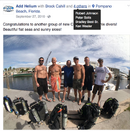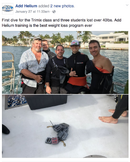nothing at all on that or if he is OK etc. Not even absolute confirmation it was Sotis except some 2-3rd hand reports (not that I question he was, just not seen a definitive statement by a witness publicly that Sotis was here."Any word on why Sotis lost consciousness?
You are using an out of date browser. It may not display this or other websites correctly.
You should upgrade or use an alternative browser.
You should upgrade or use an alternative browser.
Filmmaker Rob Stewart dies off Alligator Reef
- Thread starter DandyDon
- Start date
Please register or login
Welcome to ScubaBoard, the world's largest scuba diving community. Registration is not required to read the forums, but we encourage you to join. Joining has its benefits and enables you to participate in the discussions.
Benefits of registering include
- Ability to post and comment on topics and discussions.
- A Free photo gallery to share your dive photos with the world.
- You can make this box go away
Thank you, Cerich.it's a starting point, and generally, most of the time, the victim is within a short distance of that point. Depth, current etc all expand the cone of possibility but you absolutely need a starting point.
CuzzA
Wetwork for Hire
@cerich, from the article above.
By January he’d connected with an instructor named Peter Sotis who owns Add Helium, a dive shop in Ft. Lauderdale. According to a since-deleted Facebook post, Sotis said that he certified Stewart in a rebreather tri-mix course on January 27. Four days later, on January 31, the pair chartered a dive boat through a dive shop in Key Largo and, with the boat’s owner Dan Dawson, headed to the Queen of Nassau wreck, six nautical miles off the Florida Keys, in search of the sawfish.
rubblebath
Registered
Based on Add Helium’s Facebook page, Rob Stewart finished Mod 1 on August 3, 2016, finished Mod 2 on September 27, 2016 and started Mod 3 on January 27, 2017.
This means that Rob Stewart went from Mod 1 on a new rebreather to Mod 3 in less than 6 months. In order to qualify for Mod 3, a candidate must have a minimum of 50 hours on the specific unit and 25 dives between 140 and 200 feet.
All of these classes were with Add Helium. Even if the minimum requirements may have been met, this seems to be an extremely fast progression for rebreather certifications.
This means that Rob Stewart went from Mod 1 on a new rebreather to Mod 3 in less than 6 months. In order to qualify for Mod 3, a candidate must have a minimum of 50 hours on the specific unit and 25 dives between 140 and 200 feet.
All of these classes were with Add Helium. Even if the minimum requirements may have been met, this seems to be an extremely fast progression for rebreather certifications.
Attachments
dumpsterDiver
Banned
- Messages
- 9,003
- Reaction score
- 4,660
- # of dives
- 2500 - 4999
300 ft from the wreck is 282,857 square feet to search at 220 fsw. If you think this is easy, it isn't. Caves are much more defined and confined and still the search takes time.
First rule of seamanship, never take eyes off somebody in the water in distress, ever.
Yes it makes sense to watch or I was taught to literally point to the object of concern on the surface, however as mentioned, the diver reportedly signaled he was OK. How many crew were aboard, how many can be tasked to stand and point at things? Unless we know what personnel or resources the crew had, I see no reason to be critical.
I'm not going to argue that the ocean is not large.. but if the visibility is 50 or 100 feet and you can hang 40-50 ft off the bottom, a pair of divers on scooters can cover a pretty wide area. It sounds like a tremendous effort was made with a huge amount of resources applied to a search of the surface. I would be curious to hear about the underwater search.
Even if the minimum requirements may have been met, this seems to be an extremely fast progression for rebreather certifications.
"They were the deepest dives of Stewart’s life."
They weren't. Specifics depend on the agency. But for, say IANTD (as a random example) at least one dive needs to be to 240 feet over the course of a Rebreather Trimix class.
If these 220 foot dives (all three of them that day) were the deepest he'd ever made he should have never been certified according to standards.
aue-mike
Contributor
I'm not going to argue that the ocean is not large.. but if the visibility is 50 or 100 feet and you can hang 40-50 ft off the bottom, a pair of divers on scooters can cover a pretty wide area. It sounds like a tremendous effort was made with a huge amount of resources applied to a search of the surface. I would be curious to hear about the underwater search.
Visibility on the QON is usually poor. The wreck sits in a weird area that usually has little to no current, and the bottom consists of fine talcum powder like sediment. You usually have clear water down to about 160' or so and then you enter milky water...like dropping into a fog bank. Of the many dives I've done on this wreck I've only had two I would consider having great vis - one with about 60' and another memorable dive with ~130' of vis due to very, very frigid water from an upwelling event.
Visibility during the searches was reportedly under 10', which complicates the effort. And anytime you get close to the bottom...poof.
Dan
Contributor
... So far the only lesson I see here until more information is released is when you surface from a dive get positive immediately. I imagine many of us just keep gently kicking thinking we have obtained positive buoyancy; however, once you stop kicking you may actually be negative.
I have the same thought. At one time, when I was floating on the surface at the end of a dive, while waiting for zodiac to pick me up, I tried to stay still & found my body tended to roll over to the front & ended up my face down in the water. I thought to myself, that's not good if I passed out while floating. So, I put trim weights on the back of the BCD & lower my tank position relative to my head. It worked great. I can float stand still with my chest & face above water like when someone on life jacket. I think everyone needs to do this at the end of a checkout dive.
Dan
Contributor
Yes it makes sense to watch or I was taught to literally point to the object of concern on the surface, however as mentioned, the diver reportedly signaled he was OK. How many crew were aboard, how many can be tasked to stand and point at things? Unless we know what personnel or resources the crew had, I see no reason to be critical...
Another learning point for me is to be honest to yourself & the crew or your dive buddies about what you feel at the time. If you feel that you are about to pass out, don't give OK sign. Shake your hands, shake your head, MOF, cry for help or whatever signal you can give, except the OK sign.
St John the Diver
Contributor
Based on Add Helium’s Facebook page, Rob Stewart finished Mod 1 on August 3, 2016, finished Mod 2 on September 27, 2016 and started Mod 3 on January 27, 2017.
This means that Rob Stewart went from Mod 1 on a new rebreather to Mod 3 in less than 6 months. In order to qualify for Mod 3, a candidate must have a minimum of 50 hours on the specific unit and 25 dives between 140 and 200 feet.
All of these classes were with Add Helium. Even if the minimum requirements may have been met, this seems to be an extremely fast progression for rebreather certifications.
With predictable results.
Three dives in a day at that depth?
Bet the scrubbers hadn't been changed.
Similar threads
- Replies
- 0
- Views
- 653
- Replies
- 0
- Views
- 323
- Replies
- 1
- Views
- 927
- Replies
- 82
- Views
- 11,865
- Replies
- 1
- Views
- 759






